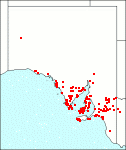Family: Haloragaceae
Haloragis acutangula
Citation:
F. Muell., Trans. Vict. lnst. 1:125 (1855).
Synonymy: H. serra ( gracilis Sonder, Linnaea 28:230 (1856).
Common name: Smooth raspwort.
Description:
Perennial herb or subshrub 20-45 cm tall, rootstock a tap root, stems erect or ascending, 4-ribbed, glabrous or scabrous with curved 1- or 2-celled hairs 0.1-0.3 mm long; leaves alternate, sessile, linear to linear-lanceolate 10-30 (rarely 50)mm long, 2-4 (rarely 8)mm wide, entire or coarsely toothed in the distal part, subfleshy, glabrous or scabrous.
Inflorescence composed of 1-7-flowered dichasia; lateral inflorescences in axils of upper leaves; bracts green, lanceolate, 5-8 (rarely 15)mm long, entire; bracteoles yellow-brown, lanceolate, 2-3 mm long, entire; flowers 4-merous, shortly pedicellate; sepals deltoid, 0.8-1 mm long, smooth; petals green to red, 2.4~3 mm long; stamens 8, anthers oblong, 1.6-2.3 mm long; styles 4, yellow-green to pink or red, c. 0.6 mm long; ovary turbinate, 0.6-1 mm long, weakly 4-ribbed.
Fruit 4-ribbed or -winged, variously ornamented; 4-locular.
|
|
Distribution:
|
Found mainly in sandy soils in coastal or subcoastal situations.
W.Aust.
|
Conservation status:
native
Flowering time: Nov. — Feb.
|

SA Distribution Map based
on current data relating to
specimens held in the
State Herbarium of South Australia
|
Biology:
No text
Taxonomic notes:
Populations are often polymorphic in their fruit shape, and the following forms can be recognised.
Key to Infraspecific taxa:
|
1. Fruit with well-defined longitudinal wings 1.5-2.5 mm wide opposite the petals |
|
|
|
2. Tubercle present between the wings |
|
|
|
3. Wings oblong, extending the full length of the fruit |
|
forma subacutangula 1i. |
|
3. Wings approximately deltoid, in the upper part of the fruit only |
|
forma semiangulata 1g. |
|
2. Fruit smooth between the wings |
|
|
|
4. Wings oblong, extending the full length of the fruit |
|
forma tetraptera 1k. |
|
|
|
5. Wing in the centre of the fruit |
|
|
|
6. Wing occupying most of the length of the fruit; fruit broader than long. |
|
forma stellata 1b. |
|
6. Wing not extending to the top and the bottom of the fruit; fruit longer than broad or isodiametric |
|
forma dentara 1c. |
|
5. Wing terminal or basal |
|
|
|
7. Wing in the upper part of the fruit only |
|
forma turbinata 1l. |
|
forma pyramidata 1f. |
|
1. Fruit lacking wings opposite the petals, or wings reduced to ribs |
|
|
|
8. Exocarp inflated, fruit globose, smooth or weakly 4-ribbed |
|
forma inflata 1d. |
|
|
|
9. Tubercle present on the fruit below the sepals |
|
|
|
10. Ribs lacking a tubercle |
|
forma tetraglebosa 1j. |
|
10. Ribs also with a basal or median tubercle; fruits fusiform or obturbinate |
|
|
|
11. Ribs with a median tubercle, fruit fusiform |
|
forma annulata 1b. |
|
11. Ribs with a basal tubercle, fruit obturbinate., forma obturbinata 1e |
|
|
|
9. No tubercle on the fruit below the sepals |
|
|
|
12. Ribs also lacking a tubercle |
|
forma acutangula 1a. |
|
12. Ribs with a median tubercle |
|
forma dentata 1c. |
Author:
Not yet available
|

